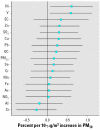Cardiovascular effects of nickel in ambient air
- PMID: 17107850
- PMCID: PMC1665439
- DOI: 10.1289/ehp.9150
Cardiovascular effects of nickel in ambient air
Erratum in
- Environ Health Perspect. 2007 Jun;115(6):A294
Abstract
Background: Fine particulate matter (FPM) in ambient air causes premature mortality due to cardiac disease in susceptible populations.
Objective: Our objective in this study was to determine the most influential FPM components.
Methods: A mouse model of atherosclerosis (ApoE-/-) was exposed to either filtered air or concentrated FPM (CAPs) in Tuxedo, New York (85 microg/m3 average, 6 hr/day, 5 days/week, for 6 months), and the FPM elemental composition was determined for each day. We also examined associations between PM components and mortality for two population studies: National Mortality and Morbidity Air Pollution Study (NMMAPS) and Hong Kong.
Results: For the CAPs-exposed mice, the average of nickel was 43 ng/m3, but on 14 days, there were Ni peaks at approximately 175 ng/m3 and unusually low FPM and vanadium. For those days, back-trajectory analyses identified a remote Ni point source. Electrocardiographic measurements on CAPs-exposed and sham-exposed mice showed Ni to be significantly associated with acute changes in heart rate and its variability. In NMMAPS, daily mortality rates in the 60 cities with recent speciation data were significantly associated with average Ni and V, but not with other measured species. Also, the Hong Kong sulfur intervention produced sharp drops in sulfur dioxide, Ni, and V, but not other components, corresponding to the intervention-related reduction in cardiovascular and pulmonary mortality.
Conclusions: Known biological mechanisms cannot account for the significant associations between Ni with the acute cardiac function changes in the mice or with cardiovascular mortality in people at low ambient air concentrations; therefore, further research is needed.
Figures





Comment in
-
Questioning sources and cardiovascular effects of nickel.Environ Health Perspect. 2007 Jun;115(6):A292-3; author reply a293-9. doi: 10.1289/ehp.115-a292. Environ Health Perspect. 2007. PMID: 17589574 Free PMC article. No abstract available.
-
Does the effect of PM10 on mortality depend on PM nickel and vanadium content? A reanalysis of the NMMAPS data.Environ Health Perspect. 2007 Dec;115(12):1701-3. doi: 10.1289/ehp.10737. Environ Health Perspect. 2007. PMID: 18087586 Free PMC article.
References
-
- Campen MJ, Nolan JP, Schladweiler MC, Kodavanti UP, Evansky PA, Costa DL, et al. Cardiovascular and thermoregulatory effects of inhaled PM-associated transition metals: A potential interaction between nickel and vanadium sulfate. Toxicol Sci. 2001;64:243–252. - PubMed
-
- Chen LC, Hwang JS. Effects of subchronic exposures to concentrated ambient particles (CAPs) in mice. IV. Characterization of acute and chronic effects of ambient air fine particulate matter exposures on heart-rate variability. Inhal Toxicol. 2005;17:209–216. - PubMed
-
- Chen LC, Nadziejko C. Effects of subchronic exposures to concentrated ambient particles (CAPs) in mice. V. CAPs exacerbate aortic plaque development in hyperlipidemic mice. Inhal Toxicol. 2005;17:217–224. - PubMed
-
- Clean Air Act Amendments 1990. 42USC7408–7409.
Publication types
MeSH terms
Substances
Grants and funding
LinkOut - more resources
Full Text Sources
Miscellaneous

